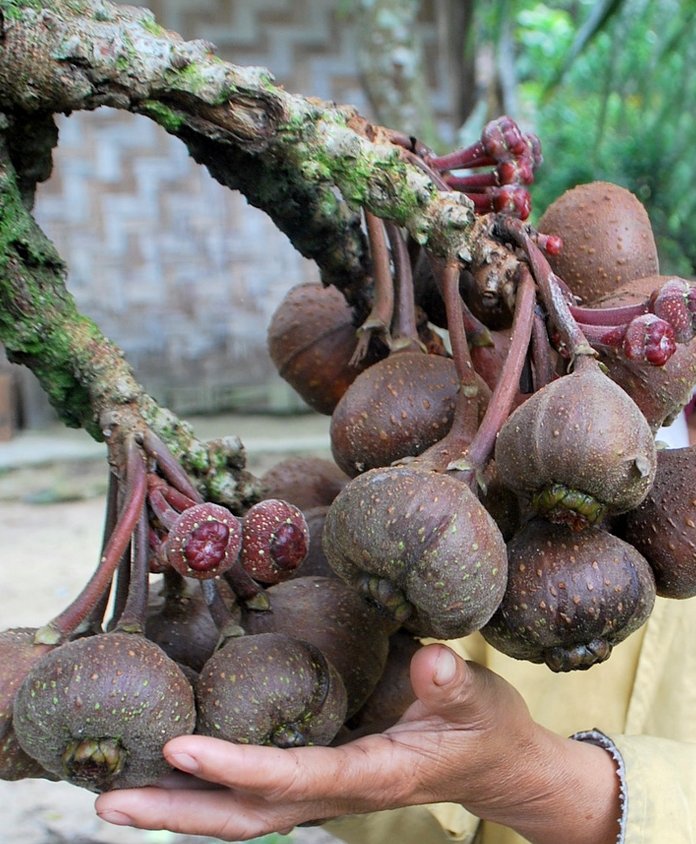 The Carolina Reaper, originally named the HP22B,is a cultivar of chili pepper of the Capsicum chinense species. It is red and has a gnarled, lumpy pod with a tail like a scythe.[2] As of 2013, Guinness has dubbed it as the hottest chilli in the world, surpassing the previous record holder, the Trinidad Scorpion.
The Carolina Reaper, originally named the HP22B,is a cultivar of chili pepper of the Capsicum chinense species. It is red and has a gnarled, lumpy pod with a tail like a scythe.[2] As of 2013, Guinness has dubbed it as the hottest chilli in the world, surpassing the previous record holder, the Trinidad Scorpion.
Bred in a Rock Hill, South Carolina greenhouse by "Smokin" Ed Currie, proprietor of the PuckerButt Pepper Company in Fort Mill, the Carolina Reaper has been certified as the world's hottest chili pepper by Guinness World Records since August 7, 2013. The original crossbreed was between a Ghost pepper (a former world record holder) and a red habanero called 'Red Savina' and is named 'Reaper' due to the shape of its tail.
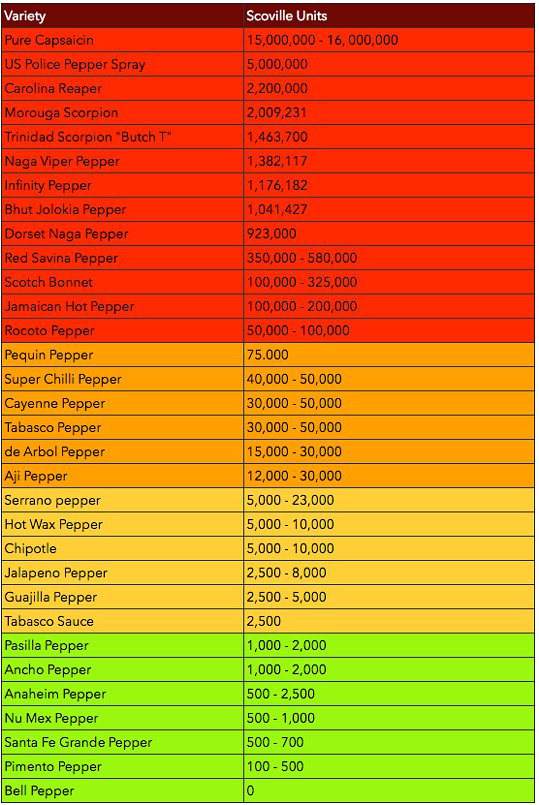 The official Guinness World Record heat level is 1,569,300 Scoville Heat Units (SHU), according to tests conducted by Winthrop University in South Carolina. The figure is an average for the tested batch; the hottest individual pep
The official Guinness World Record heat level is 1,569,300 Scoville Heat Units (SHU), according to tests conducted by Winthrop University in South Carolina. The figure is an average for the tested batch; the hottest individual pep
per was measured at 2.2 million SHU.
Hot Pepper Seeds Source
Thursday
Worlds Hottest Chili Pepper
Posted by
Garden Medusa
0
comments
![]()
Labels: Aji Limon, Bhut Jolokia, Capsicum chinense, Carolina reaper, ghost pepper, peruvian chili, rare chili, rare pepper, rocotto, tree chili, Trinidad scorpion, worlds hottest pepper
Exotic Climbing Pandanus
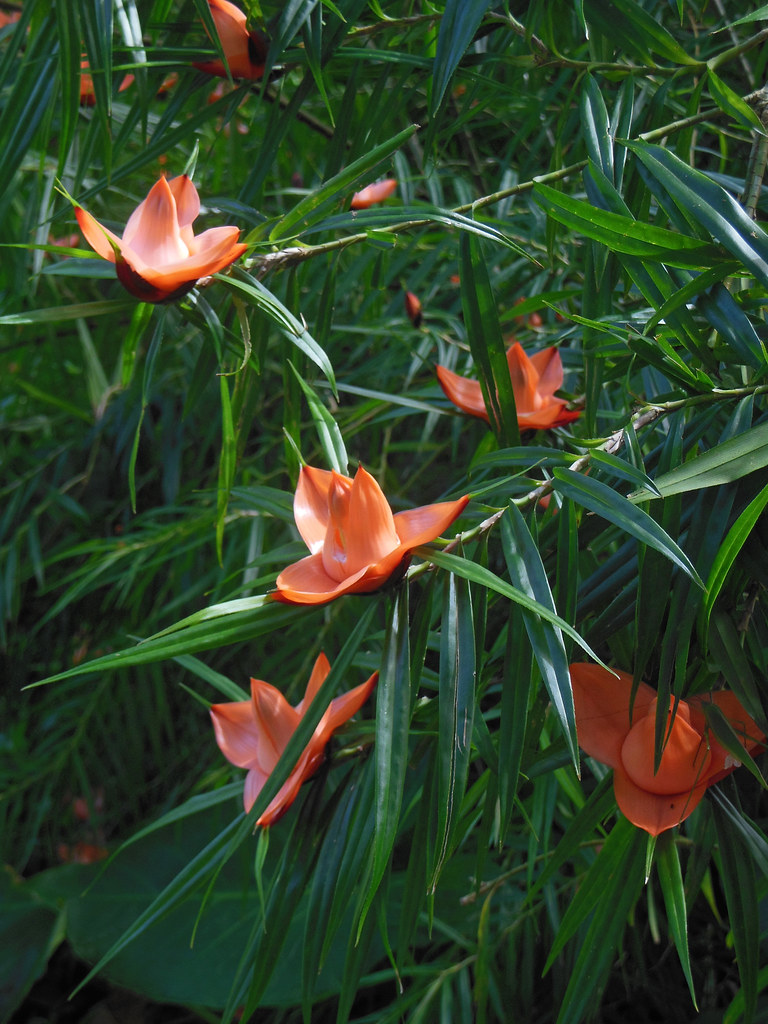 Native to Tropical Asia, Malesia and Philippines,
Freycinetia is an evergreen specimen climber with stems that can grow
from 1-6 foot long. The slender roots of Freycinetia grow along the stem
attaching the plant to the tree, shrub or trellis on which it is
growing.
Native to Tropical Asia, Malesia and Philippines,
Freycinetia is an evergreen specimen climber with stems that can grow
from 1-6 foot long. The slender roots of Freycinetia grow along the stem
attaching the plant to the tree, shrub or trellis on which it is
growing.The leaves of Freycinetia cumingiana are dark green, linear-oblong, and leathery and can grow up to 12-15” long. The male (staminate) and female (pistillate) flowers are found on different plants and both are densely arranged within cylindrical spikes (inflorescences). Clusters of 3 or 4 inflorescences containing either male or female flowers are borne at the ends of branches above several showy pinkish-orange bracts that form beneath the inflorescenses.
Flowers are good for cutting. Tender Perennial. Protect from frost. Suitable for indoors.
Syn: Freycinetia multiflora
Posted by
Garden Medusa
0
comments
![]()
Labels: Climbing Pandanus, exotic orange, Freycinetia cumingiana, Freycinetia multiflora, pandan
Tuesday
Alpine Tufted Horned Rampion Physoplexis comosa
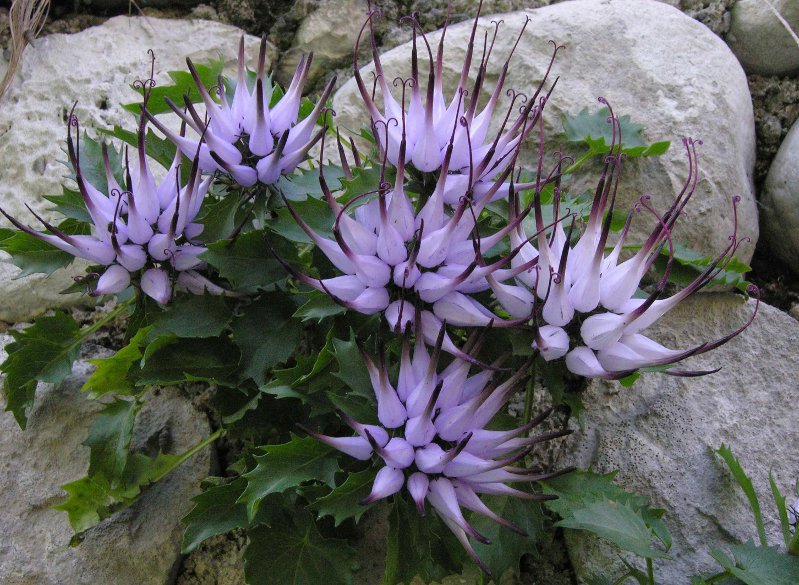 Wow, something very unusual...
Wow, something very unusual...
From a fat, fleshy rootstock grow tufted rosettes
of shallow to deeply toothed, reniform leaves. The erect to decumbent
stems have smaller, short-stalked, lanceolate leaves and are 2-4” inches
long. Tight, globular heads of 20 or more flowers, each to 1” inch
long, are held at the ends of each stem, and each flower is a delicate
object in itself. A pale lilac inflated flask or club-like base that, as
it tapers to a very thin neck, changes color to a deep or almost
blackish purple. From the end of the thin neck protrudes the deep purple
forked and twisted stigma.
It grows in narrow, lofty crevices of limestone cliffs in the southern
Alps and the Dolomites to around 2000 m, where the roots creep through
any narrow cracks and anchor the plant firmly to the rocks. There is no
humus in the crevices, but a very sandy substratum. It prefers to grow
on shady, damp, limey rocks and does not like low winter temperatures
nor dry, hot summers, but a humid and cool climate. Very rarely white
forms or red colored may occur. Zones 5-8.
This is not an easy plant to grow. It needs slug protection and is best placed in a crevice or containers.
Seeds found here....
Posted by
Garden Medusa
0
comments
![]()
Labels: exotic hardy, Hardy Devil's Claw, Physoplexis comosa, Rampion, Tufted Horned, unusual alpine
Thursday
Elephant Ear Roxburgh's Fig
This is a evergreen to semi-deciduous, spreading, large shrub or small tree reaching 15’ feet tall and as wide.
Ficus auriculata is the Fig tree with the largest leaves in the rain forests of the Chinese Yunnan province.
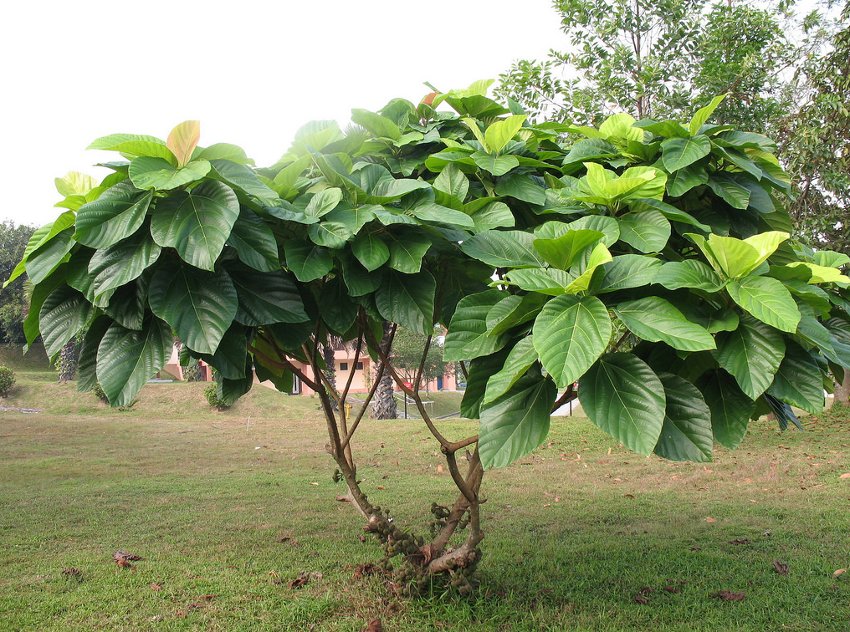 The young evergreen leaves are
starting intensely red, and turn the greenest when reaching their
ultimate size of up to 20” inches length. It can also easily be trimmed
and the plant reacts with even more shoots and leaves on a thicker stem.
The new growth is a deep red. Figs form in clusters on the trunk and
larger branches, are green and red on the inside.
The young evergreen leaves are
starting intensely red, and turn the greenest when reaching their
ultimate size of up to 20” inches length. It can also easily be trimmed
and the plant reacts with even more shoots and leaves on a thicker stem.
The new growth is a deep red. Figs form in clusters on the trunk and
larger branches, are green and red on the inside. The whole fruit tastes fairly sweet. It is full of an attractive jelly-like substance, which is much sweeter than the pulp. The absence of acidity, however, makes it slightly flat in taste. The overall fruit quality is good and is used to make jams, juices and curries. Zone 9+
Seeds....
Posted by
Garden Medusa
3
comments
![]()
Labels: Elephant Ear, Ficus auriculata, foliage tree, large leaf tree, ornamental tree, rare fruit, Roxburgh Fig, roxburghii, small tree, tropical tree, unusual edibles, unusual fruit, weird fruit
Mediterranean Spurge
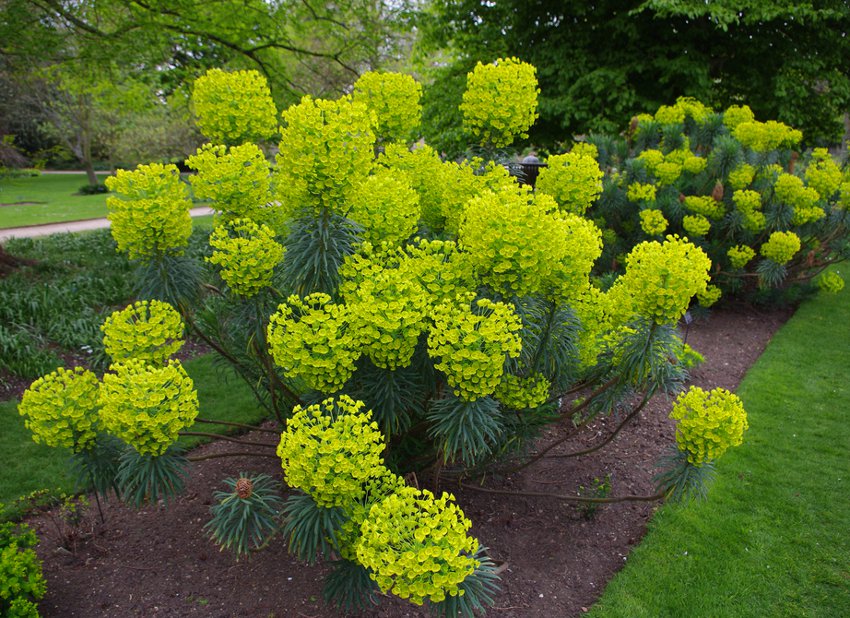 The whole plant grows 3-5’ feet tall and wide, making it a perfect focal
point for a spot with well-drained soil and full sun. The milky sap may
cause irritation to skin and eyes. Do not eat! USDA Zones 7 to 10.Seeds Euphorbia characias subsp. wulfenii is a dramatic
perennial plant that grows into a large robust plant.
The whole plant grows 3-5’ feet tall and wide, making it a perfect focal
point for a spot with well-drained soil and full sun. The milky sap may
cause irritation to skin and eyes. Do not eat! USDA Zones 7 to 10.Seeds Euphorbia characias subsp. wulfenii is a dramatic
perennial plant that grows into a large robust plant.
In late winter to
early spring great club-like inflorescences emerge from the crown.
Bright chartreuse flower-like bracts glow in the garden of particularly
large flowers with an intense color.
The overall effect is eye-catching
and lasts well into June. At about the same time, new shoots emerge
holding narrow, grey-green leaves.
Posted by
Garden Medusa
0
comments
![]()
Labels: amazing plant, chartreuse, dramatic plant, Euphorbia Characias, hard to find seeds, Mediterranean Spurge, tall spurge, unusual plant, wulfenii, Yellow Green
Friday
Rare Calico Monkey Flower Mimulus pictus
A truly rare gem. Calico Monkey Flower Mimulus pictus
This wildflower is endemic to California, found only above the southeastern San Joaquin Valley within Kern County and Tulare County.
It is known only from the western Tehachapi Mountains and southernmost Sierra Nevada foothills, at elevations of 443–4,101 ft. It grows in open California oak woodland habitat, in bare rocky soils around granite outcrops.
Nothing like any Mimulus you have ever seen. A very rare and unusual plant with creamy-white rounded petals delicately patterned with fine dark-red to purplish brown spider web-like lines. Foliage is velvet fuzzy textured. Loves a well drained but moist soil in light shade. Zone 8+. Low growing about 6" to 12" in well drained, moist soil, sun or part shade.
Seeds available here:
Posted by
Garden Medusa
0
comments
![]()
Labels: Calico flower, Calico MonkeyFlower, endangered botanical, endangered species, Mimulus pictus, rare flower
Dioscorea elephantipes Elephant Foot Caudiciform
Dioscorea elephantipes (syn. Testudinaria elephantipes), also commonly known as turtle back, elephant's foot, Hottentots' bread is one of the most beautiful, weird and wonderful, caudiciform plants around!
It has a deeply fissured surface, resembling an elephant's foot, hence its common name. It makes a most interesting container plant. The stems grow in a climbing fashion. The leaves are heart-shaped. Flowers are pale greenish yellow and normally appear in winter.
It is believed the Khoisan used to bake the starchy, bread-like trunk which was used as a food source. Other members in the genus Dioscorea are used to extract steriodal saponins which are used to produce cortisone and and contraceptives.
Easily grown in any well drained inorganic soil.
Seed Source: Dioscorea elephantipes
Posted by
Garden Medusa
0
comments
![]()
Labels: caudiciform, Dioscorea elephantipes, elephant's foot, fascinating plant, fat plant, Hottentots bread, rare plant, Testudinaria elephantipes, turtle back, unusual plant, weird plant
Rare Heirloom Giant White Choclo Corn from the Inca empire - Cuzco
 Choclo, is a variety of corn, also referred to as
Peruvian corn or Cuzco corn (named for the capital city of the Inca
empire - Cuzco), is a large kernel corn from the Andes. It is consumed
in parts of Central America and South America, especially in Peru,
Bolivia and Colombia. Kernels are 1/2" inch and cobs grow to 8" inches.
Choclo, is a variety of corn, also referred to as
Peruvian corn or Cuzco corn (named for the capital city of the Inca
empire - Cuzco), is a large kernel corn from the Andes. It is consumed
in parts of Central America and South America, especially in Peru,
Bolivia and Colombia. Kernels are 1/2" inch and cobs grow to 8" inches.
Choclo is used in the making of humitas in Bolivia, choclo arepas (Corn
Griddle Cakes) in Colombia and for pastel de choclo (Corn Pie).
In Peru, choclo is commonly served as an accompaniment to dishes such as
ceviche, and its toasted, salted form, similar to corn nuts, are
customarily given free to restaurant patrons upon being seated. Full
ears of choclo are also a popular street food in Peru and other Andean
countries, typically served with a slice of cheese as choclo con queso.
Finger foods like choclo con queso mirror the popularity of corn on the
cob as a convenient street snack in Latin America.
I wonder if it makes giant popcorn as well :)
Seed Source: Choclo Perivuan Giant White Corn
Posted by
Garden Medusa
0
comments
![]()
Labels: Blanco Gigante, Choclo Cuzco, Corn Choclo, Corn Seeds, Cusco Corn, Cuzco, Cuzco Maize, Gigante Cusco, Peruvian corn, Peruvian Maize, rare corn, rare heirloom vegetables, rare seeds, Rareseeds, south American corn
Grow Your Own Pistachio Nuts!
Posted by
Garden Medusa
0
comments
![]()
Labels: fresh pistachio, fresh pistachio seeds, fresh pistacio, green peanut butter, grow your own pistacio, nut trees, pistachio plant, pistachio seedling, pistacio plant, plant gift, raw nuts, raw pistachio

